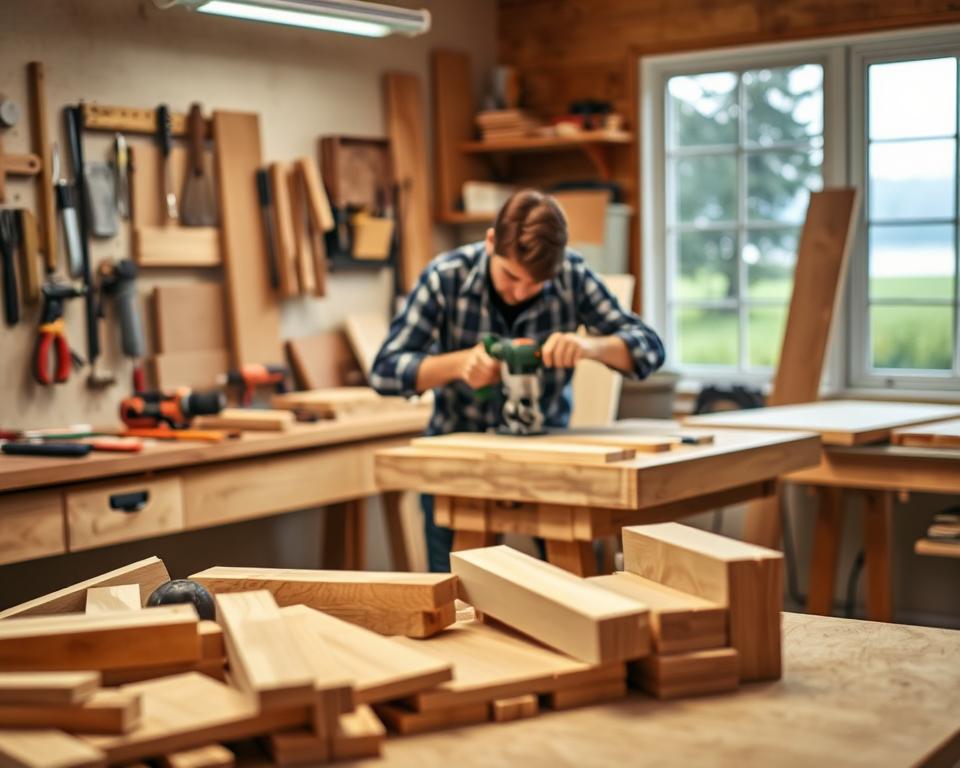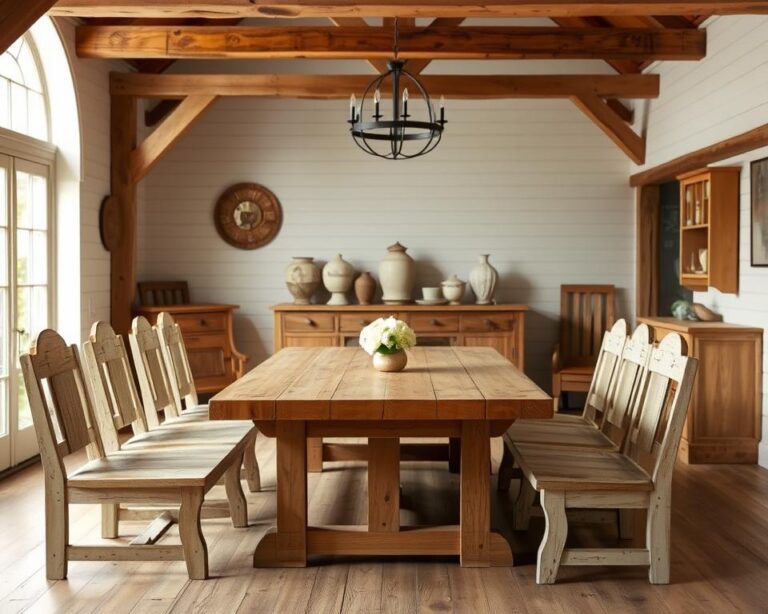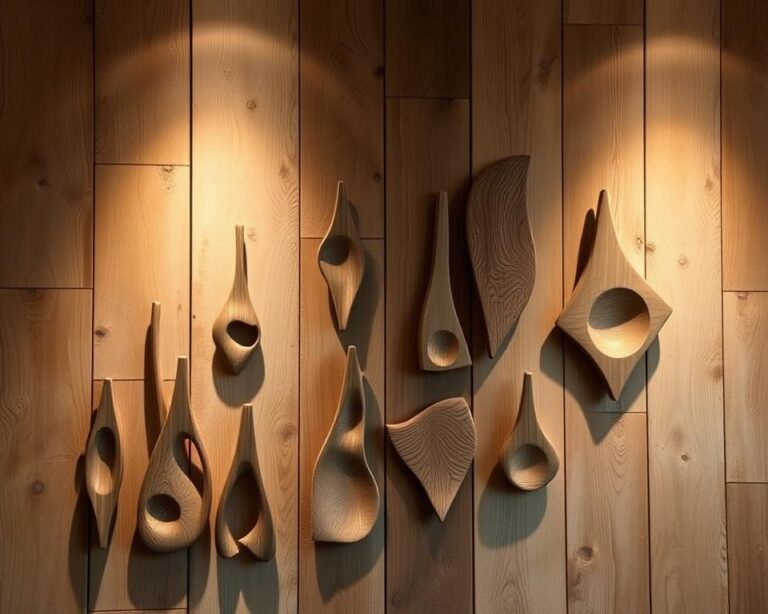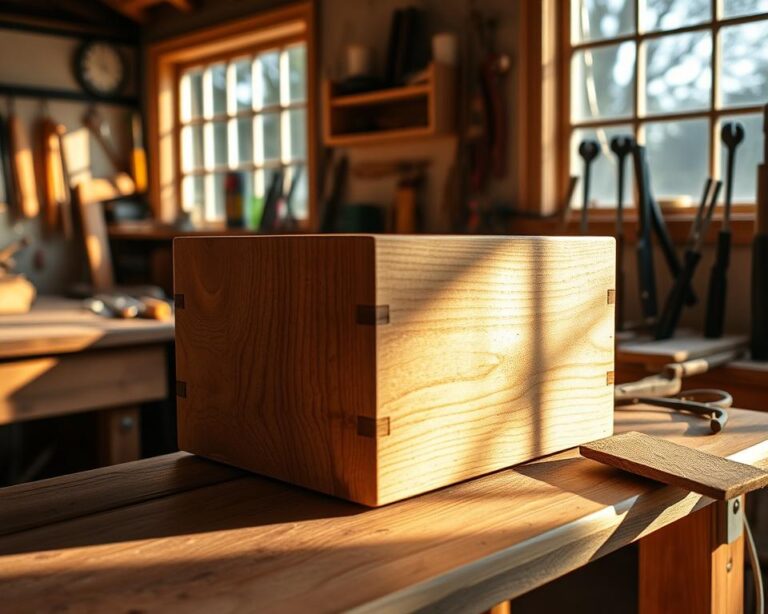Did you know over 60% of Americans tried DIY projects last year? This shows many people are learning skills like woodworking. It’s a great time for you to start too. Woodworking lets you make things that are both pretty and useful for your home.
Starting with the basics of woodworking is fun. You will learn how to turn simple materials into amazing items. There are lots of easy projects for beginners. You can make furniture, decor, or fun things for the family. Woodworking can make you feel proud and strong.
To start woodworking, you first need to learn some basic skills and get the right tools. Then, you’re ready to enjoy making things by hand. So, get ready, and let’s dive into your woodworking journey today!
Understanding Wood Types for Your Projects
Getting to know different wood types is key for anyone starting with woodworking. It helps to know how softwoods and hardwoods are not the same. This can make a big difference in what you choose to make and how you do it.
Softwoods vs. Hardwoods
Softwoods are from trees that grow fast, like coniferous trees. They are usually not as hard, which makes them easier to work with. Pine and fir are softwoods often used by beginners. Hardwoods, however, come from trees that lose their leaves. Woods such as oak and maple are hard and last longer. They also look nice as a finished product. Choosing between softwood and hardwood depends on your project and the look you want.
Common Wood Species and Their Uses
Knowing about common wood types helps pick the best material for your projects. Each wood type has its own special features and uses:
| Wood Species | Type | Common Uses |
|---|---|---|
| Pine | Softwood | Furniture, shelving, and crafts |
| Fir | Softwood | Construction, framing, and cabinetry |
| Oak | Hardwood | Flooring, furniture, and cabinetry |
| Maple | Hardwood | Tables, cabinets, and musical instruments |
Understanding the different wood types and what they’re used for makes planning your projects easier. It also helps improve the quality of what you make. This knowledge is a big help as you start your journey in woodworking.
Essential Woodworking Tools for Beginners
Starting your woodworking journey? You’ll need to know about key tools to help you. Choosing the right tools can make your projects turn out great. They also keep the process fun and easy. This part talks about hand and power tools, plus safety gear for new woodworkers.
Hand Tools Every Woodworker Should Own
Hand tools are crucial for any woodworker’s collection. Having these essential tools is important when you start:
- Saws: Essential for cutting various materials and shaping your projects.
- Chisels: Used for precise carving and shaping of wood.
- Clamps: Important for holding pieces together during assembly.
- Hammers: A necessity for driving nails and dowels into your work.
Power Tools to Consider for DIY Projects
As you get more skilled, power tools can make your projects easier and faster. Here are some key power tools to think about adding:
- Circular saws: Perfect for straight cuts in large pieces of wood.
- Drills: Useful for creating holes and driving screws.
- Sanders: Help achieve a smooth finish on your projects.
Safety Equipment for Woodworking
Staying safe is super important in woodworking. You’ll need good safety gear to protect against dangers. Here’s what to include:
- Goggles: Essential for safeguarding your eyes from flying debris.
- Gloves: Offer protection for your hands against cuts and splinters.
- Dust masks: Important for preventing inhalation of wood dust and particles.
Setting Up Your Woodworking Space
Setting up an efficient woodworking space is key. It can increase your productivity and safety. The right setup not only makes woodworking more enjoyable but also boosts your success. We’ll talk about how to create a workspace that fits your needs and skills.
Choosing the Right Location
Finding the perfect spot for woodworking is essential. You need a well-ventilated area with enough room for your tools and projects. A garage or shed is ideal because it lets you organize everything. Good lighting is also important to see your work well.
Essential Workbench Features
Your workbench is central to your woodworking area. It needs to be strong and stable for all kinds of tasks. Let’s look at important features:
- Height: It should be comfortable to reduce strain.
- Stability: Choose a workbench that can handle heavy use.
- Built-in storage: Drawers or shelves make keeping tools close by easier.
Basic Woodworking Techniques
Learning the basics of woodworking is key to making great projects. Knowing how to measure correctly ensures your projects are the right size. Also, knowing how to cut and sand properly gives your finished piece a clean look.
Measuring and Marking for Accuracy
Good measurements are the base of any woodworking project. Use tools like tape measures and squares to get your size right. Then, mark with a pencil to guide your cuts. When working on projects, accurate measuring techniques keep your lines straight and angles correct.
Cutting Techniques: Saws and More
Finding the best way to cut wood is crucial. Different saws do different jobs. A saw with fine teeth makes smooth cuts. A jigsaw works great for complex shapes. Always cut a bit outside the lines. This extra space lets you sand down to just the right size. Learning these woodworking techniques for beginners helps make your pieces fit perfectly.
Sanding for a Smooth Finish
Sanding is important for a nice finish on your project. Start with rough sandpaper and switch to finer grits for a smooth surface. This makes your project look and feel better. Check out this detailed guide on woodworking techniques to improve your work.
Creating Your First Woodworking Project
Learning by doing is key when you start with woodworking. Tackling simple projects builds your confidence and skills. Pick an easy project that matches what you know already.
Selecting a Simple Design
Think about easy designs for your first project. A simple shelf or a wooden chopping board are good starts. They let you practice key skills like cutting and making things smooth. Pick a project that you’re excited about to keep your interest high.
Gathering Your Materials
Get all the stuff you need before starting. This includes wood, like pine or plywood, and tools such as a saw and a sander. Here’s a quick list:
- Wood of your choice
- Measuring tape
- Clamps
- Saw
- Sander
- Safety goggles
Step-by-Step Project Walkthrough
Let’s break down the steps:
- Measure and mark the wood for your design.
- Use a saw to cut the wood pieces right.
- Make the edges and surface smooth to prevent splinters.
- Put the pieces together, using clamps if needed.
- Add your chosen finish or paint at the end.
Follow these steps to finish your first woodworking project. Remember to be patient and enjoy it!
Finishing Techniques in Woodworking
The final touch on your woodworking projects matters a lot. It makes them look good and last longer. Choosing the right finish can turn a simple project into something special. The choice between stains and paints is important. Each one gives a different look and feel.
Types of Finishes: Stains vs. Paints
It’s important to know about the finishes you can use. Here’s a look at stains versus paints:
| Feature | Stains | Paints |
|---|---|---|
| Appearance | Enhances wood grain; adds color | Opaque finish; cover the wood grain |
| Durability | May require reapplication; less protective | More durable; provides a protective layer |
| Application | Typically requires less prep | May need primer and multiple coats |
| Maintenance | Easy to touch up | More difficult to touch up once damaged |
How to Apply a Finish Properly
To get a pro look, applying the finish right is key. Here are steps for a good finish:
- Prepare the Surface: Make sure the wood is clean and smooth. Sanding and dusting off is essential.
- Choose the Right Tools: Pick a brush, roller, or cloth that fits your finish. Brushes are great for paints, and cloths are best for stains.
- Apply Even Coats: Start with thin layers and let each dry well. This avoids drips and uneven spots.
- Follow Manufacturer Instructions: Every finish has its own drying time and method. Stick to these rules.
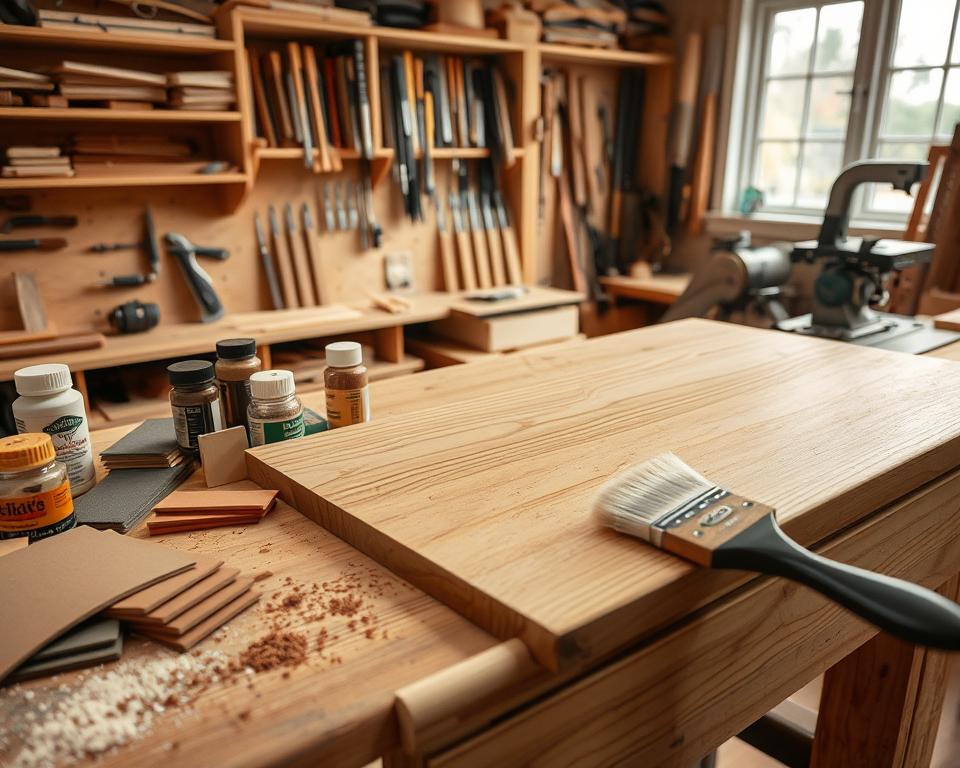
Maintaining Your Woodworking Tools
Taking good care of your woodworking tools is crucial for top performance. When you look after your tools, they last longer and make your work better. This guide offers tips on taking care of both hand tools and power tools.
Cleaning and Caring for Hand Tools
It’s important to clean hand tools regularly. Do this after every use:
- Use a dry cloth to wipe off any dust and moisture.
- Put a thin layer of oil on metal parts to stop rust.
- Make sure to sharpen blades for easier cutting and to reduce wear and tear.
- Keep your tools in a place that’s dry and cool to avoid rust and other damage.
Power Tool Maintenance Tips
Power tools need careful maintenance because they are complex. To keep them working well, do the following:
- Check and change brushes, bearings, and belts when necessary.
- Ensure air vents are open for proper cooling and ventilation.
- After use, clean blades, drill bits, and other parts to keep them sharp.
- Before using, look over cords and plugs for damage to ensure safety.
Safety First: Woodworking Safety Tips
Woodworking is both fun and rewarding. But, your safety should always be the top priority. It’s important to know how to avoid injuries and use tools correctly. We’ll show you how to stay safe while working on your projects.
Proper Handling of Tools
Handling tools the right way helps prevent accidents. Make sure you:
- Choose the correct tool for each job to work efficiently and safely.
- Keep your tools sharp and in good condition; dull tools are risky.
- Keep your work area clean to prevent trips and stay focused.
- Be aware of what’s happening around you, especially with power tools.
Personal Protective Equipment (PPE)
Wearing the right PPE is key for safety in woodworking. You must have:
- Safety goggles to keep your eyes safe from dust.
- Hearing protection to protect your ears from noise.
- Dust masks to avoid breathing in harmful dust.
By sticking to these safety tips, you make woodworking safer and more fun. Taking the right steps lets you be creative and productive without risking your health.
Joining Techniques You Should Know
Learning about different joining techniques is key in woodworking. It boosts your projects’ strength and looks. You’ll see many kinds of woodworking joints, good for various uses. Here, we’ll go over simple and more advanced joints, giving you the insights to improve your skills.
Basic Wood Joints: Butt and Lap Joints
Butt joints and lap joints are basic but essential in woodworking. A butt joint connects wood ends together. It’s easy, perfect for beginners. Even if it’s simple, the right finish can make it strong and good-looking.
Lap joints, however, are more durable. They happen when one piece covers another, giving more area for glue. They’re best for frames or strong structures. Knowing these basic joints is the first step towards more complex ones.
Advanced Joints: Dovetail and Mortise
As you get better at woodworking, you’ll find dovetail and mortise joints invaluable. Dovetail joints have interlocking parts, offering top strength. They’re best for drawers and quality furniture, showing off your skills.
The mortise joint involves cutting a space in one wood piece for another to fit tightly. It’s great for stable furniture. Mastering these joints highlights your precision and eye for detail.
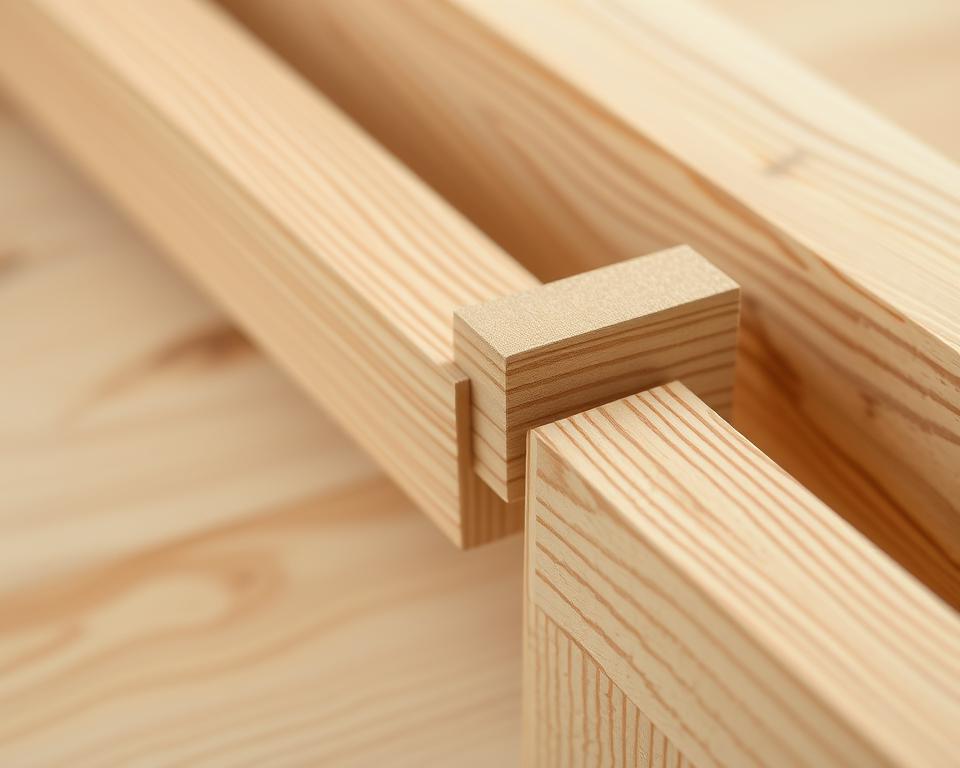
Woodworking Projects for Beginners
Starting in woodworking is thrilling, especially with beginner projects. These projects need few materials, so they’re easy and fun. You get to make cool stuff like birdhouses, neat shelves, or toys and games. Plus, you learn a lot.
Birdhouses: A Great Starting Point
Making a birdhouse is a great first project. It’s a chance to try different woods and simple building steps. You can design it for specific birds and make it unique with paint. It’s also good for the environment, giving birds a home.
Simple Shelves to Try at Home
Building simple shelves helps improve your place and your building skills. You can pick floating or corner shelves. It’s a project that boosts your woodworking and adds something useful to your home.
Toys and Games: Fun DIY Ideas
Crafting toys and games sparks your creativity. You can make things like wooden blocks or puzzles that are fun and teach something. These projects are great for beginners because they’re not too hard.
| Project Type | Skill Level | Materials Needed | Time Required |
|---|---|---|---|
| Birdhouses | Beginner | Wood, nails, paint | 2-3 hours |
| Simple Shelves | Beginner | Wood, brackets, screws | 1-2 hours |
| Toys and Games | Beginner | Wood, sandpaper, paint | 2-4 hours |
Resources for Learning Woodworking
Learning woodworking lets you dive into a world full of creativity and skills. There’s a bunch of resources out there to help you, no matter if you’re just starting or getting better at what you already know. Looking at different places for learning woodworking can make the journey fun and help you get really good at this rewarding activity.
Online Tutorials and Courses
Online, you’ll find tons of tutorials and courses suited for any skill level. YouTube has free instructional videos, while Udemy and Skillshare offer in-depth courses for a fee. These sources give you step-by-step lessons to make learning easier. They include:
- Video tutorials showing basic techniques.
- Interactive courses that let you practice while learning.
- Community forums for asking questions and sharing progress.
Books and Magazines for Inspiration
Books and magazines about woodworking are great for ideas and learning. They often have plans for projects, pictures, and tips from experts. Creating a collection of your favorite woodworking books and magazines can really help you learn. Here are some good picks:
- *The Complete Manual of Woodworking* by Albert Jackson for basic techniques.
- *Woodworker’s Journal* for modern projects and advice.
- *Wood magazine*, filled with different designs and methods.
Joining a Woodworking Community
Joining a woodworking community can really change your journey as a woodworker. Meeting others who love woodworking can give you lots of knowledge and create friendships that make woodworking more fun. It doesn’t matter if you’re just starting or have some experience, talking with fellow woodworkers will push you to try new projects and get better.
Finding Local Woodworking Clubs
To find local woodworking clubs, you should look at community centers, libraries, or craft stores near you. Many clubs are happy to have beginners and they offer workshops to teach you skills from expert woodworkers. Being part of these clubs also helps you meet people for advice and sharing woodworking stories.
Online Forums and Groups to Connect With
If you can’t find local clubs, the internet has many online forums and groups for woodworkers. Websites like Facebook and Reddit have many woodworking discussions where you can ask questions, share your work, and get feedback. Being active online helps you find support and make friends with the same passion for woodworking, improving your skills and love for the craft.

